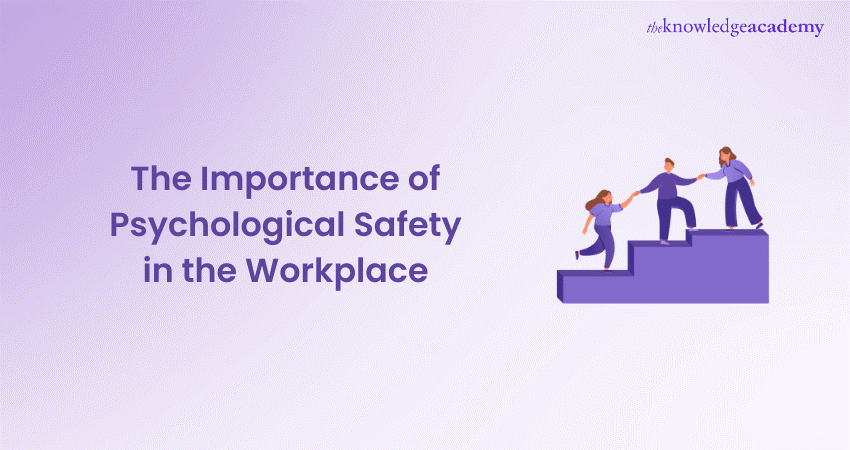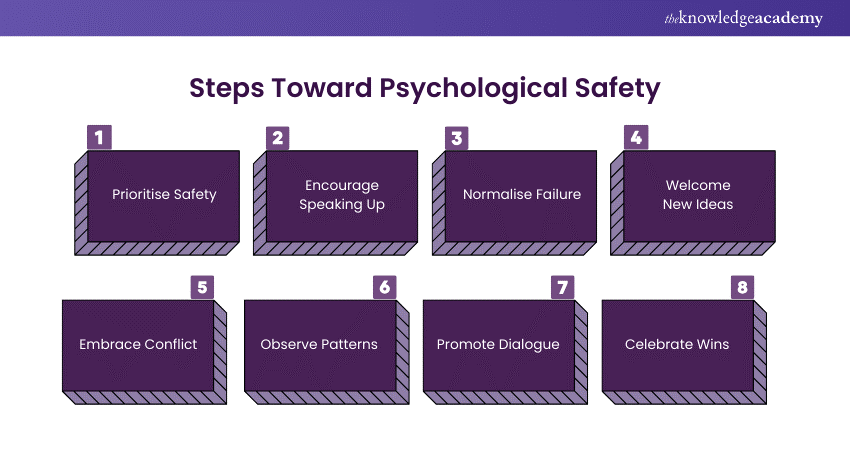We may not have the course you’re looking for. If you enquire or give us a call on +44 1344 203 999 and speak to our training experts, we may still be able to help with your training requirements.
Training Outcomes Within Your Budget!
We ensure quality, budget-alignment, and timely delivery by our expert instructors.

Would you rather work in an environment that is restrictive of your thoughts and words? Or one that encourages freedom of speech? Surely, it’s the latter! Now imagine working in a place where you can share your wildest ideas without fear, ask questions freely, and admit mistakes without dread. That’s what Psychological Safety is all about.
It’s about feeling secure enough to be yourself and take risks without the worry of being judged or punished. This kind of environment boosts creativity, strengthens teamwork, and makes everyone feel more engaged and valued. Let's explore why Psychological Safety is so important and how you can create it in your workplace.
Table of Contents
1) What is Psychological Safety?
2) Why is Psychological Safety Important?
3) The Three Fundamentals of Psychological Safety
4) 8 Steps Toward Creating More Psychological Safety at Work
5) The Benefits of Psychological Safety
6) Conclusion
What is Psychological Safety?
Psychological Safety is a notion that you won’t be punished or shamed for speaking up about how you feel. Where you can share new ideas, ask questions, raise concerns, or make mistakes. It’s about creating an environment where you feel safe to take risks and be vulnerable in front of others. In such a setting, you and your colleagues can freely share information and collaborate effectively.
Why is Psychological Safety Important?
Psychological Safety is essential for several reasons:
a) Fosters Innovation: When you feel safe to express new ideas, even if they seem unconventional, it encourages creativity and innovation.
b) Enhances Collaboration: A psychologically safe environment promotes open communication and teamwork, leading to better problem-solving and decision-making.
c) Improves Employee Engagement: When you feel valued and heard, your engagement and commitment to the organisation increase.
d) Reduces Stress: Knowing you can make mistakes without severe repercussions helps reduce anxiety and stress at work.
The Three Fundamentals of Psychological Safety
To create a psychologically safe workplace, focus on these three fundamentals:
a) Inclusion: Ensure everyone feels included and valued.
b) Learning Orientation: Encourage a growth mindset where mistakes are seen as learning opportunities.
c) Open Dialogue: Promote honest and respectful communication.
8 Steps Toward Creating More Psychological Safety at Work
Now that you have understood the base concept and importance of Psychological Safety at the workplace, let's see how you can incorporate this with your team. Here are eight steps towards creating more Psychological Safety at work:

1) Make Psychological Safety an Explicit Priority
Start by making Psychological Safety a clear and explicit priority. Talk about it openly and emphasise its importance in meetings, training sessions, and company communications. Ensure that leaders model the behaviour by being open, approachable, and supportive when team members speak up.
2) Facilitate Everyone Speaking up
Encourage the members of the team to share their thoughts and ideas by creating a healthy culture where every voice matters. Regular team meetings, suggestion boxes, and anonymous feedback channels can provide platforms for employees to express themselves without fear. Recognise and validate contributions to make everyone feel valued.
Aid in creating a safe space for everyone around you with our Mindfulness Training - Sign up now!
3) Establish Norms for How Failure Is Handled
Develop clear norms for how your team handles failure. Emphasise that mistakes are simply opportunities for learning and growth rather than reasons for punishment. When failures occur, discuss them openly to extract lessons and improve processes, reinforcing a culture of continuous improvement.
4) Create Space for New Ideas
Foster an environment where the team's creativity and innovation are highly encouraged. Make it clear that all ideas are welcome, even unconventional ones. Organise brainstorming sessions where team members can freely share their thoughts without fear of criticism. This openness can lead to breakthroughs and innovative solutions.
5) Embrace Productive Conflict
Teach your team to see conflict as a natural and necessary part of the creative process. Encourage healthy disagreements that can lead to better solutions. Ensure conflicts are resolved respectfully and constructively, with a focus on finding common ground and mutual understanding.
Learn to manage stress mindfully and build resilience with our Handle Stress And Develop Your Resilience Training - Register now!
6) Pay Close Attention and Look for Patterns
Observe your team’s interactions closely to identify any behaviours or practices that may hinder Psychological Safety. Look for patterns in communication, participation, and feedback. Address any issues promptly and adjust your approach as needed to foster a more supportive environment.
7) Make an Intentional Effort to Promote Dialogue
Promote open and honest dialogue by encouraging your team to share their thoughts and concerns regularly. Create platforms for ongoing communication and feedback, such as regular check-ins, town hall meetings, and one-on-one sessions. Ensure that all team members feel heard and valued.
8) Celebrate Wins
Celebrate both individual and team successes to reinforce a positive environment. Acknowledge and reward contributions, no matter how small. Celebrating wins fosters a sense of accomplishment, boosts morale, and encourages continued effort and innovation.
Lend your ears to those that need to be heard, sign up for our Active Listening Training to help pay attention to what others may have to say!
The Benefits of Psychological Safety
Psychological Safety brings numerous benefits to the workplace, including:
a) Increased Innovation: A safe environment encourages creative thinking and innovation.
b) Better Collaboration: Teams work more effectively when members feel safe enough to share their opinions and innovative ideas.
c) Higher Employee Engagement: Employees who feel psychologically safe are more engaged and committed to their work.
d) Reduced Turnover: A supportive work environment reduces employee turnover and increases retention.
e) Enhanced Performance: Overall team performance improves when members feel safe and supported.
Conclusion
Psychological Safety is a cornerstone of a happy, healthy and productive workplace. By fostering an environment where everyone feels safe and comfortable to express themselves and take risks, you can drive innovation, enhance collaboration, and improve overall organisational success. Make Psychological Safety a priority, and watch your workplace transform into a thriving, supportive community.
Having a hard time managing the people around you? Our course on Dealing With Difficult People can help! - Sign up today!
Frequently Asked Questions

Barriers to Psychological Safety include fear of judgment, lack of trust, poor communication, and punitive responses to mistakes.

A lack of Psychological Safety would result in employees feeling afraid to speak up, share ideas, or admit mistakes, leading to disengagement and low morale.

Improving Psychological Safety involves promoting open communication, encouraging risk-taking, handling failures constructively, and creating an inclusive environment.

The Knowledge Academy takes global learning to new heights, offering over 30,000 online courses across 490+ locations in 220 countries. This expansive reach ensures accessibility and convenience for learners worldwide.
Alongside our diverse Online Course Catalogue, encompassing 17 major categories, we go the extra mile by providing a plethora of free educational Online Resources like News updates, Blogs, videos, webinars, and interview questions. Tailoring learning experiences further, professionals can maximise value with customisable Course Bundles of TKA.

The Knowledge Academy’s Knowledge Pass, a prepaid voucher, adds another layer of flexibility, allowing course bookings over a 12-month period. Join us on a journey where education knows no bounds.

The Knowledge Academy offers various Health & Safety Courses, including Advance First-Aid Training, Active and Healthy Lifestyle Training, and Counselling Certifications. These courses cater to different skill levels, providing comprehensive insights into What is Yoga.
Our Health & Safety Blogs cover a range of topics related to Panic and Anxiety Attacks, offering valuable resources, best practices, and industry insights. Whether you are a beginner or looking to advance your Health and Safety knowledge, The Knowledge Academy's diverse courses and informative blogs have you covered.
Upcoming Health & Safety Resources Batches & Dates
Date
 Psychology Course
Psychology Course
Fri 14th Feb 2025
Fri 11th Apr 2025
Fri 13th Jun 2025
Fri 15th Aug 2025
Fri 10th Oct 2025
Fri 12th Dec 2025







 Top Rated Course
Top Rated Course



 If you wish to make any changes to your course, please
If you wish to make any changes to your course, please


